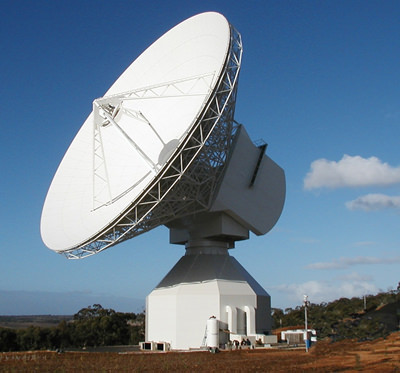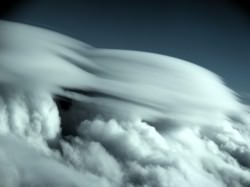A Top-Secret Explosion in M82
Supernovae are extremely luminous explosions of stars and cause bursts of radiation that often outshine an entire galaxy. So, when a supernova exploded last year in a nearby galaxy, why didn’t we see it? Was this an undercover supernova; a top-secret, covert event? Well, kind of. The secret is in the dust.
(...)
Read the rest of A Top-Secret Explosion in M82 (896 words)
Mars Rover Has a New Name
The Mars Science Laboratory rover, scheduled for launch in 2011, now has a new name, thanks to a sixth-grade student from Kansas. Twelve-year-old Clara Ma submitted the winning entry, “Curiosity” in the name-the-rover contest for schoolchildren, sponsored by NASA. “We have been eager to call the rover by name,” said Pete Theisinger, who manages the JPL team building and testing Curiosity. “Giving it a name worthy of this mission’s quest means a lot to the people working on it.”
For winning the naming contest, Clara gets to sign her name directly on the rover. But you can send your name to Mars with Curiosity, too.
(...)
Read the rest of Mars Rover Has a New Name (285 words)
Distant black hole poses for a close-up

1H0707-495
Astronomers have probed closer than ever to a supermassive black hole lying deep at the core of a distant active galaxy that was once thought to be shrouded in dust — which will greatly advance the look captured in this NASA file image from the mid-1990s. Using new data from ESA’s X-ray Multi-Mirror Mission (XMM)-Newton spaceborne observatory, researchers peered into the innermost depths of the object, which lies at the heart of the galaxy known as 1H0707-495.
“We can now start to map out the region immediately around the black hole,” says Andrew Fabian, at the University of Cambridge, who headed the observations and analysis.
(...)
Read the rest of Distant black hole poses for a close-up (278 words)
Where In The Universe #56
It’s Wednesday (already?!) so that means its time for another “Where In The Universe” challenge to test your visual knowledge of the cosmos. This week’s image was submitted by UT reader Rob Bowman, and Rob is hoping to stump everyone this week. Try to guess/name where in the Universe this image is from, and give yourself extra points if you can name the spacecraft responsible for the image. Make your guess and post a comment, but please no links to the answer. Check back sometime on Thursday to find the answer and see how you did. Good luck!
(...)
Read the rest of Where In The Universe #56 (0 words)
UT Briefs: Shuttle Lands, Re-living Phoenix
Space Shuttle Lands
Space shuttle Atlantis landed safely in California on Sunday morning after “dynamic and unpredictable” weather kept the orbiter from returning to Florida. Atlantis touched down on runway 22 of Edwards Air Force Base at 11:39 am EDT (1539 GMT) Sunday, the first of two opportunities to land the shuttle in California. Atlantis spent nearly 13 days in orbit on the STS-125 mission, successfully repairing and upgrading the Hubble Space Telescope during a series of five spacewalks. Atlantis will be ferried to Kennedy Space Center on top of a modified 747 in about a week. Next shuttle mission: STS-127, slated for liftoff on June 13, on a trip to the International Space Station.
(...)
Read the rest of UT Briefs: Shuttle Lands, Re-living Phoenix (88 words)
Bolden Nominated as NASA Administrator; Shuttle Landing Delayed
About the same time space shuttle Atlantis’ landing was waved off today due to continued rainy weather in Florida, the White House announced that former shuttle commander Charles Bolden Jr. will be nominated as NASA’s next administrator. President Obama also chose Lori Garver to be Bolden’s deputy administrator. Obama said, “These talented individuals will help put NASA on course to boldly push the boundaries of science, aeronautics and exploration in the 21st century and ensure the long-term vibrancy of America’s space program.”
(...)
Read the rest of Bolden Nominated as NASA Administrator; Shuttle Landing Delayed (334 words)
Opportunity Reveals Long-time Water, Winds at Victoria

A sizable collaboration of researchers has unveiled an enormous set of data from NASA’s Opportunity rover today — data that testify to the rover’s lucky longevity, and paint a picture of climate events that have shaped Victoria Crater, shown in this NASA/JPL-Caltech image.
The climate history is vast and compelling, including dramatic floods and terrain-shaping winds spanning billions of years. The data appear in today’s issue of the journal Science.
(...)
Read the rest of Opportunity Reveals Long-time Water, Winds at Victoria (766 words)
New, Deep Image of Virgo Cluster Reveals Galaxy Cut Short in its
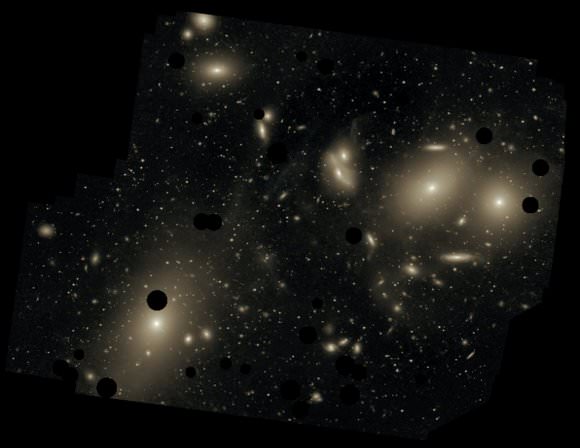
Astronomers have peered deep inside the Virgo cluster, and measured the size of one of its most famous members — Messier 87 — with surprising results.
The giant elliptical galaxy isn’t quite as giant as previously believed.
This deep image of the Virgo Cluster, obtained by Chris Mihos of Case Western Reserve University and his colleagues using the university’s Burrell Schmidt telescope, shows the diffuse light between the galaxies belonging to the cluster. North is up, east to the left. The dark spots indicate where bright foreground stars were removed from the image.
(...)
Read the rest of New, Deep Image of Virgo Cluster Reveals Galaxy Cut Short in its Youth (559 words)
A Cold and Wet History on Early Mars?
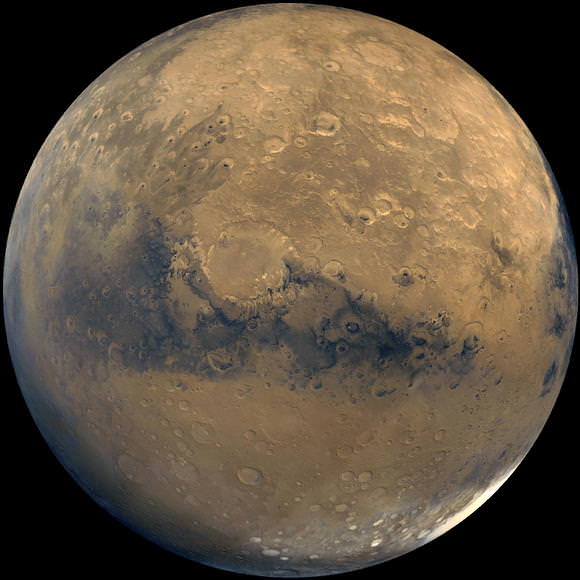
Even if an early Mars never got above freezing, the brine on its surface could have stayed liquid and supported life, a new study says.
Lead author Alberto G. Fairen, of NASA Ames Research Center in Moffett Field, California, and his colleagues have analyzed the behavior of Martian chemical concentrations found at various mission landing sites, and revealed that warm temperatures wouldn’t have been necessary to support salt-loving life forms.
(...)
Read the rest of A Cold and Wet History on Early Mars? (196 words)
Where In The Universe #55
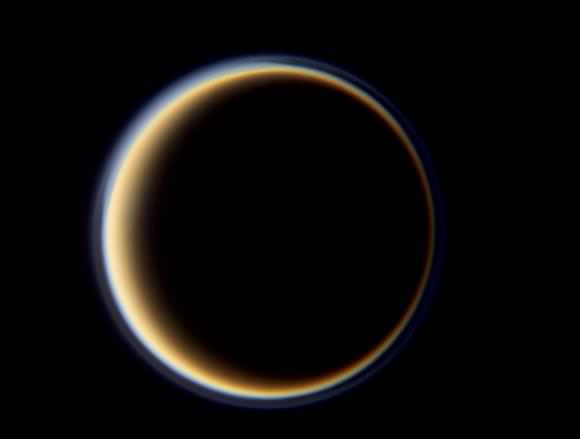
Are you ready for another Where In The Universe Challenge? Take a look and see if you can name where in the Universe this image is from. Give yourself extra points if you can name the spacecraft responsible for the image. As usual, we’ll provide the image today, but won’t reveal the answer until tomorrow. This gives you a chance to mull over the image and provide your answer/guess in the comment section. Please, no links or extensive explanations of what you think this is — give everyone the chance to guess.
(...)
Read the rest of Where In The Universe #55 (0 words)
IYA Live Telescope Today: Jupiter and Neptune Conjunction - M19
![]() Hey, hey! We’re baaaack… Due to some technical difficulties, our eye on the southern sky has been down for a short time, but I’m happy to report that we’re back up and running again. If you missed our broadcast yesterday and today, have no fear. We recorded the Jupiter and Neptune conjunction for you and captured Messier 19 today, too! Come on… You know you want to look! (...)
Hey, hey! We’re baaaack… Due to some technical difficulties, our eye on the southern sky has been down for a short time, but I’m happy to report that we’re back up and running again. If you missed our broadcast yesterday and today, have no fear. We recorded the Jupiter and Neptune conjunction for you and captured Messier 19 today, too! Come on… You know you want to look! (...)
Read the rest of IYA Live Telescope Today: Jupiter and Neptune Conjunction - M19 (231 words)
Herschel Phones Home — Literally
For the first time in spaceflight history, a satellite has used mobile phone technology to radio back to Earth. The Herschel spacecraft – which launched on May 14, called home two days later using the same technology used in GSM mobile phone networks to send test data to ESA’s deep space tracking station. “Herschel’s 1.5-Mbps test transmission - roughly the same data rate provided by a home broadband Internet connection - was picked up at ESA’s ESTRACK station at New Norcia, Australia, on Saturday, as the satellite was travelling some 280 000 km from Earth,” said John Dodsworth, the Herschel-Planck Flight Operations Director.
(...)
Read the rest of Herschel Phones Home — Literally (219 words)
Cosmologists Improve on Standard Candles Measurement
Cosmologists have found a new and quicker technique that establishes the intrinsic brightness of Type Ia supernovae more accurately than ever before. These exploding stars are the best standard candles for measuring cosmic distances and are the tools that made the discovery of dark energy possible. An international team has found a way to do the job of measuring stellar distances in just a single night as opposed to months of observations by simply measuring the ratio of the flux (visible power, or brightness) between two specific regions in the spectrum of a Type Ia supernova. With this new method, a supernova’s distance can be determined to better than 6 percent uncertainty.
(...)
Read the rest of Cosmologists Improve on Standard Candles Measurement (389 words)
Poetry in Space: Final Pilgrims to the Hubble Space Telescope
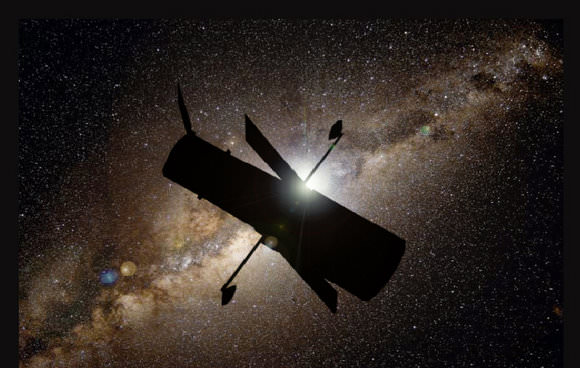
As today’s final spacewalk of the Hubble Servicing Mission begins, it seems very fitting to share a poem written by my friend Stuart Atkinson. Stuart is a poet, a blogger, a member of Unmanned Spaceflight.com (which means he is a Photoshopper extraordinaire!) and a passionate promoter of space exploration. Stuart has written many touching poems previously about the Mars rovers, the Phoenix lander, the Kepler mission and many other missions, but this verse about the final human mission to the Hubble Space Telescope is priceless. See below for “The Final Pilgrims” and check out Stu’s website Cumbrian Skies for more great poetry, images and information.
(...)
Read the rest of Poetry in Space: Final Pilgrims to the Hubble Space Telescope (9 words)
3 new stories for 2009/05/19
A team of atmospheric chemists has moved closer to what’s considered the “holy grail” of climate change science: the first-ever direct detections of biological particles within ice clouds. Ice in Clouds Experiment - Layer Clouds (ICE-L) team mounted a mass spectrometer onto a C-130 aircraft and made a series of high-speed flights through a type of cloud known as a wave cloud. Analysis of the ice crystals revealed that the particles that started their growth were made up almost entirely of either dust or biological material such as bacteria, fungal spores and plant material. While it has long been known that microorganisms become airborne and travel great distances, this study is the first to yield direct data on how they work to influence cloud formation.
(...)
Read the rest of First Observations of Biological Particles in High-Altitude Clouds (371 words)





